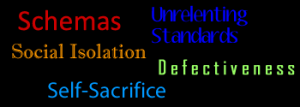Schema Therapy: Transforming Lifelong Patterns for a Fulfilling Life
Have you ever noticed certain patterns in your life, such as dating the wrong type of person or getting angry in similar situations? Have you wondered why you haven’t achieved the success you want in your career or personal life? Do you often feel like an outsider or feel defective? Schema therapy, a groundbreaking form of cognitive therapy, delves deep into these ingrained patterns, offering a path to lasting change and satisfaction.
Perhaps you don’t struggle with mood or anxiety issues, but you’re a professional or high-level athlete looking to take your game to the next level utilizing proven psychological principles. Schema therapy can help you achieve these goals by addressing underlying patterns that may be holding you back.
Understanding Schemas
Schemas are deep-seated, enduring patterns formed during childhood or adolescence that continue to influence our lives. Therefore, these patterns shape our perceptions, emotions, and behaviors, often without our conscious awareness. Furthermore, schemas are self-perpetuating and can be highly resistant to change, making them challenging to overcome without targeted therapy.
How Schema Therapy Works
Schema therapy, developed by Dr. Jeffrey Young, builds upon traditional cognitive therapy to address more complex, long-term issues. This therapy is interactive and structured, comprising three main components: assessment, experiential work, and behavioral change.
- Assessment: In this initial phase, Dr. Shapiro identifies the specific schemas affecting your life. Through detailed discussions and questionnaires, he uncovers the root causes of your recurring issues.
- Experiential Work: Here, Dr. Shapiro uses various techniques to deeply explore and understand how these schemas manifest in your life. This phase might include imagery exercises, role-playing, and emotional exploration to connect past experiences with current behaviors.
- Behavioral Change: The final phase focuses on transforming these patterns. Dr. Shapiro works with you to replace maladaptive schemas with healthier ones, setting you on a path toward achieving your personal and professional goals.
What Makes Schema Therapy Unique?
Schema therapy stands out from other therapeutic approaches in several ways:
- Interactive and Collaborative: Schema therapy is a highly interactive process. Dr. Shapiro works closely with clients, creating a strong therapeutic alliance. This collaboration ensures active involvement in the healing journey.
- Roadmap and Plan: From the outset, schema therapy provides a clear roadmap. There are specific and measurable goals, ensuring that progress can be tracked and tangible results can be seen over time.
- Deep Emotional Work: Unlike some therapies that focus primarily on changing thoughts and behaviors, schema therapy delves into deeper emotional layers. Clients not only understand their challenges and their causes but also develop strategies to improve them. This deeper emotional work leads to authentic and lasting changes, allowing clients to change how they feel about certain aspects of their life fundamentally.
- Comprehensive Approach: Dr. Scott Shapiro, an Advanced Certified Schema Therapist and Psychopharmacologist, offers a holistic approach. By combining schema therapy with psychopharmacology, he provides treatments, strategies, and solutions all in one place. If medications are necessary, Dr. Shapiro can manage this aspect of care seamlessly.
Addressing a Range of Challenges
Schema therapy is particularly effective for individuals facing a variety of challenges, including anxiety, depression, burnout, imposter syndrome, shame, and adult ADHD. Dr. Shapiro also works with individuals who are generally doing well but wish to improve their relationships with significant others, children, families, and colleagues. Moreover, schema therapy can enhance work performance, help overcome blocks, and achieve the next level of success. Dr. Shapiro has also assisted athletes in enhancing their performance and competitiveness.
Take the first step today and call Dr. Shapiro at 212-631-8010 or email at scott@scottshapiromd.com.
Enhancing Performance for High-Level Achievers
Schema therapy has expanded beyond traditional mental health challenges to help high-level performers such as professional athletes, C-suite executives, and leaders. These individuals often face unique pressures and performance-related issues that schema therapy can address effectively. Therefore, by understanding and transforming the underlying patterns that affect performance, schema therapy helps high achievers enhance their capabilities, overcome psychological barriers, and reach their full potential.
Common Schemas and Their Impact
Understanding specific schemas can provide insight into how schema therapy might benefit you. Following are some common schemas and their typical manifestations:
- Emotional Deprivation: The belief that one’s emotional needs will never be met by others. This can lead to feelings of loneliness and disconnection. For example, a person with this schema may struggle to form close relationships because they expect others to be emotionally unavailable.
- Abandonment/Instability: The expectation that significant relationships will inevitably end. This can result in anxiety and difficulty forming stable attachments. A person with this schema might constantly worry that their partner will leave them.
- Defectiveness/Shame: A deep-seated belief in one’s own flaws and unworthiness. This often leads to feelings of shame and fear of rejection. Individuals with this schema may avoid intimacy to prevent others from seeing their perceived defects.
- Social Isolation/Alienation: The feeling of being different and disconnected from others. This can cause avoidance of social situations and difficulty forming meaningful relationships. Someone with this schema might feel like an outsider in most social settings.
- Unrelenting Standards: The belief that one must always strive for perfection, leading to chronic stress and burnout. Individuals with this schema often push themselves excessively, fearing failure or criticism if they do not meet their high standards.
- Dependence/Incompetence: The belief that one cannot handle everyday responsibilities without significant help from others. This can lead to excessive reliance on others for decision-making and support.
- Vulnerability to Harm or Illness: An exaggerated fear that imminent catastrophe will strike at any moment. Individuals with this schema may take extreme precautions to protect themselves from perceived threats.
- Subjugation: The belief that one’s own needs and desires must be suppressed to avoid conflict or rejection. This can result in feelings of resentment and lack of fulfillment.
- Self-Sacrifice: An excessive focus on meeting the needs of others at the expense of one’s own needs. This often leads to feelings of burnout and resentment.
- Approval-Seeking/Recognition-Seeking: The excessive need for approval and recognition from others. Individuals with this schema might prioritize others’ opinions over their own needs and values.
Case Study: Lisa’s Journey to Fulfillment
Consider Lisa, a 35-year-old graphic designer who struggled with feelings of inadequacy and isolation. In spite her talent and success at work, she felt she could never measure up and often avoided social interactions, fearing rejection. There, this in part caused her relationships were shallow, and she was unable to connect deeply with others.

Credit: iStock-Credit:pixelheadphoto-Feeling Overwhelmed or Stuck at Work? Schema Therapy Can Help. Finding a psychiatrist near you can help. Scott Shapiro, MD -psychiatrist meds + therapy can help.
Credit:iStock-pixelheadphoto
Initially, Lisa’s therapist identified several schemas, including Defectiveness/Shame and Social Isolation/Alienation. Then, here therapist created a treatment plan and discussed this with Lisa in a collaborative manager. After a discussion of the assessment and the core schemas, they began schema therapy.
Through schema therapy, Lisa engaged in cognitive techniques to challenge her negative beliefs about herself. She also participated in experiential exercises, such as imagining positive interactions with others and expressing her feelings of shame and isolation in a safe environment.
As Lisa progressed through therapy, she began to develop healthier relationships and a stronger sense of self-worth. She learned to approach social situations with more confidence and started forming meaningful connections. Her work life improved as she embraced her skills and contributions, no longer held back by self-doubt.
Take the first step today and call Dr. Shapiro at 212-631-8010 or email at scott@scottshapiromd.com.
A Case of Undiagnosed Adult ADHD and Schema Therapy
Now, let’s consider Mark, a 40-year-old entrepreneur running a medium-sized company who had struggled for decades with professional setbacks and personal dissatisfaction. Despite his best efforts, Mark felt he could never achieve his true potential and often doubted his abilities. He had frequent conflicts at work and found it difficult to maintain focus, which led to missed deadlines and poor performance reviews. Mark also experienced deep feelings of shame and believed he was inherently flawed. These schemas likely developed due to a childhood filled with high expectations and criticism, leaving Mark feeling perpetually inadequate.

Are you struggling at work? Procrastinate? Overwhelmed? Late? NYC ADHD Psychiatrist Scott Shapiro, MD Can- Help. Source-iStock Credit:PeopleImages
Credit: iStock PeopleImages
Dr. Shapiro was the first psychiatrist to recognize that Mark’s struggles were not solely due to professional pressures but also undiagnosed adult ADHD, compounded by the Defectiveness/Shame and Unrelenting Standards schemas. First, Dr. Shapiro conducted a thorough assessment that included validated questionnaires, an extensive interview, and speaking with Mark’s previous treaters. Secondly, Dr. Shapiro discussed with Mark the diagnosis and treatment recommendations which included a referral to his primary care doctor, a referral to a sleep specialist since Mark described symptoms of a sleep disorder, the option of medications and schema therapy. After a collaborative discuss with Mark about the diagnosis and treatment, they began medications and schema therapy. Within months, Mark made significant progress including his business expanding by twenty-five percent, creating better boundaries between his work and family life, and feeling more confident and competent.
Comprehensive Assessment and Treatment
Dr. Shapiro conducted a thorough assessment to diagnose ADHD, including detailed interviews, standardized questionnaires, and discussions about Mark’s life history. Once diagnosed, Dr. Shapiro provided psychoeducation about ADHD, explaining its impact on Mark’s life and offering practical strategies to manage symptoms.
Integrated Therapeutic Approach
Dr. Shapiro’s treatment plan combined medication management for ADHD with schema therapy to address the deep-rooted feelings of shame and inadequacy. Thus, cognitive-behavioral techniques helped Mark reframe negative thoughts about his abilities, while experiential exercises allowed him to confront and process emotions related to his schemas. This holistic approach not only improved Mark’s focus and productivity but also his self-esteem and emotional well-being.
The Importance of Addressing Underlying Schemas
Addressing the Defectiveness/Shame schema was crucial. Without tackling this underlying issue, Mark would likely continue to experience self-doubt and emotional turmoil, even with effective ADHD treatment. Schema therapy helped Mark understand the origins of his feelings and develop healthier, more constructive beliefs about himself.
Long-Lasting Change
Dr. Shapiro’s comprehensive approach ensured that after each session, Mark left with written key takeaways, next steps, new strategies, and key insights. This practice helped Mark retain important information, apply new techniques consistently, and track his progress over time, leading to long-lasting positive change.
The Benefits of Schema Therapy
Schema therapy offers profound benefits by addressing the root causes of emotional and behavioral issues. By understanding and transforming these deep-seated patterns, clients can achieve lasting change, leading to a more satisfying and happier life.
A Comprehensive Approach with Dr. Scott Shapiro
Dr. Scott Shapiro, an Advanced Certified Schema Therapist and Psychopharmacologist, provides a comprehensive approach to your care. By integrating schema therapy with psychopharmacology, he ensures you receive a well-rounded treatment plan. Whether through therapeutic techniques or medication management, Dr. Shapiro offers all the necessary treatments, strategies, and solutions in one place.
Dr. Shapiro is deeply committed to helping you achieve your goals and ensuring the changes you make are long-lasting. “I believe in providing a comprehensive approach to therapy that addresses both the mind and body,” says Dr. Shapiro. After most sessions, clients leave with new insights, strategies, and next steps written down so they can refer, review, and remember them over time. This structured approach helps clients stay on track and make meaningful progress.
Take the first step today and call Dr. Shapiro at 212-631-8010 or email at scott@scottshapiromd.com.
Learn More About Schema Therapy
Ready to break free from destructive patterns and create a more fulfilling life? Contact Dr. Shapiro, a certified schema therapist in NYC, to learn more about how schema therapy can help you achieve your goals.
Explore the transformative power of schema therapy today and take the first step towards a brighter future. Call Dr. Shapiro now at 212-631-8010 or email scott@scottshapiromd.com.
Frequently Asked Questions (FAQs)
- What is a schema?
A schema is a deeply ingrained pattern of thought and behavior that develops during childhood or adolescence. These patterns are shaped by early life experiences and continue to influence how individuals perceive and react to situations throughout their lives. Schemas can be positive or negative, but when they are maladaptive, they often lead to persistent emotional and behavioral issues.
- What is schema therapy?
Schema therapy is a form of cognitive therapy that targets these deep-seated patterns or schemas. Developed by Dr. Jeffrey Young, schema therapy combines elements of cognitive-behavioral therapy, attachment theory, and experiential techniques to help individuals identify and change maladaptive schemas. The therapy involves three main phases: assessment, experiential work, and behavioral change, aiming to replace harmful schemas with healthier, more adaptive ones.
- Who can benefit from schema therapy?
Schema therapy is particularly effective for individuals facing a variety of challenges, including anxiety, depression, burnout, imposter syndrome, shame, and adult ADHD. It also benefits high-level performers such as athletes, executives, and leaders who wish to enhance their performance, overcome psychological barriers, and achieve their full potential. Additionally, individuals who are generally doing well but wish to improve their relationships or work performance can benefit from schema therapy.
- What makes Dr. Scott Shapiro’s schema therapy approach unique?
Dr. Shapiro combines schema therapy with psychopharmacology, offering a holistic treatment plan that addresses both psychological and medical needs. His approach ensures that all necessary treatments, strategies, and solutions are provided in one place, making the process seamless and comprehensive for his clients. Dr. Shapiro is deeply committed to his clients’ success and ensures they leave each session with new insights, strategies, and next steps written down for ongoing reference and progress.
- How can schema therapy help with ADHD?
Schema therapy, combined with medication management, helps individuals with ADHD by addressing the root causes of their challenges. It provides psychoeducation about ADHD, offers practical strategies to manage symptoms, and works on underlying schemas such as Defectiveness/Shame. This comprehensive approach leads to improved focus, productivity, self-esteem, and emotional well-being.
Take the first step today and call Dr. Shapiro at 212-631-8010 or email at scott@scottshapiromd.com.
*Disclaimer: Details of cases have been altered to protect the confidentiality of any and all individuals. The material contained here is not intended in any way to replace proper medical supervision or advice. All decisions which may impact your health should be discussed with your physician.
Bibliography
- Young, J.E., Klosko, J.S., & Weishaar, M.E. (2003). Schema Therapy: A Practitioner’s Guide. New York: Guilford Press.
- Arntz, A., & van Genderen, H. (2009). Schema Therapy for Borderline Personality Disorder. Chichester, England: Wiley-Blackwell.
- Rafaeli, E., Bernstein, D.P., & Young, J. (2011). Schema Therapy: Distinctive Features. London: Routledge.
- Biederman, J., Faraone, S.V., Spencer, T., Mick, E., Monuteaux, M.C., & Aleardi, M. (2006). Functional impairments in adults with self-reports of diagnosed ADHD: A controlled study of 1001 adults in the community. Journal of Clinical Psychiatry, 67(4), 524-540.
- Beck, A.T., Rush, A.J., Shaw, B.F., & Emery, G. (1979). Cognitive Therapy of Depression. New York: Guilford Press.
- Biederman, J., Faraone, S.V., & Monuteaux, M.C. (2002). Impact of exposure to parental ADHD on clinical features and dysfunction in the offspring. Psychological Medicine, 32(5), 817-827.
- Kessler, R.C., Adler, L., Barkley, R., Biederman, J., Conners, C.K., Demler, O., & Faraone, S.V. (2006). The prevalence and correlates of adult ADHD in the United States: Results from the National Comorbidity Survey Replication. American Journal of Psychiatry, 163(4), 716-723.

